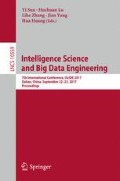Abstract
This paper investigates the problem of object segmentation in cluttered environment. This problem enables a large variety of exciting and important applications. An interactive perception method is proposed to segment scene into constituent objects based on principal angle. Trajectory data of feature points reflecting the essence of scene structure changes is extracted by a robot arm to calculate least stable regions for the interactive task. The segmentation task is achieved by the principal angle of stable regions because the principal angle essentially estimates the similarity between two regions. In contrast to probability based approach, our method performs well on efficiency of segmentation as it works without estimating parameters of the system. Experimental results on real world scene confirm the effectiveness of our method.
Access this chapter
Tax calculation will be finalised at checkout
Purchases are for personal use only
References
Schiebener, D., Ude, A., Asfour, T.: Physical interaction for segmentation of unknown textured and non-textured rigid objects. In: 2014 IEEE International Conference on Robotics and Automation (ICRA), pp. 4959–4966. IEEE (2014)
Lyubova, N., Ivaldi, S., Filliat, D.: From passive to interactive object learning and recognition through self-identification on a humanoid robot. Auton. Robot. 40(1), 33–57 (2016)
Hausman, K., Niekum, S., Osentoski, S., Sukhatme, G.S.: Active articulation model estimation through interactive perception. In: 2015 IEEE International Conference on Robotics and Automation (ICRA), pp. 3305–3312, May 2015
Chang, L., Smith, J.R., Fox, D.: Interactive singulation of objects from a pile. In: 2012 IEEE International Conference on Robotics and Automation (ICRA), pp. 3875–3882, May 2012
van Hoof, H., Kroemer, O., Peters, J.: Probabilistic segmentation and targeted exploration of objects in cluttered environments. IEEE Trans. Robot. 30(5), 1198–1209 (2014)
Kenney, J., Buckley, T., Brock, O.: Interactive segmentation for manipulation in unstructured environments. In: 2009 IEEE International Conference on Robotics and Automation, ICRA 2009, pp. 1377–1382, May 2009
Yan, J., Pollefeys, M.: A factorization-based approach to articulated motion recovery. In: 2005 IEEE Computer Society Conference on Computer Vision and Pattern Recognition (CVPR 2005), vol. 2, pp. 815–821, June 2005
Golub, G.H., Van Loan, C.F.: Matrix Computations, vol. 3. JHU Press, Baltimore (2012)
Yan, J., Pollefeys, M.: A general framework for motion segmentation: independent, articulated, rigid, non-rigid, degenerate and non-degenerate. In: Leonardis, A., Bischof, H., Pinz, A. (eds.) ECCV 2006. LNCS, vol. 3954, pp. 94–106. Springer, Heidelberg (2006). doi:10.1007/11744085_8
Björck, A., Golub, G.H.: Numerical methods for computing angles between linear subspaces. Math. Comput. 27(123), 579–594 (1973)
van Hoof, H., Kroemer, O., Amor, H.B., Peters, J.: Maximally informative interaction learning for scene exploration. In: 2012 IEEE/RSJ International Conference on Intelligent Robots and Systems, pp. 5152–5158, October 2012
Fowlkes, E.B., Mallows, C.L.: A method for comparing two hierarchical clusterings. J. Am. Stat. Assoc. 78(383), 553–569 (1983)
Hausman, K., Balint-Benczedi, F., Pangercic, D., Marton, Z.-C., Ueda, R., Okada, K., Beetz, M.: Tracking-based interactive segmentation of textureless objects. In: 2013 IEEE International Conference on Robotics and Automation (ICRA), pp. 1122–1129. IEEE (2013)
Author information
Authors and Affiliations
Corresponding author
Editor information
Editors and Affiliations
Rights and permissions
Copyright information
© 2017 Springer International Publishing AG
About this paper
Cite this paper
Wu, R., Zhao, D., Liu, J., Tang, X., Huang, Q. (2017). Autonomous Object Segmentation in Cluttered Environment Through Interactive Perception. In: Sun, Y., Lu, H., Zhang, L., Yang, J., Huang, H. (eds) Intelligence Science and Big Data Engineering. IScIDE 2017. Lecture Notes in Computer Science(), vol 10559. Springer, Cham. https://doi.org/10.1007/978-3-319-67777-4_30
Download citation
DOI: https://doi.org/10.1007/978-3-319-67777-4_30
Published:
Publisher Name: Springer, Cham
Print ISBN: 978-3-319-67776-7
Online ISBN: 978-3-319-67777-4
eBook Packages: Computer ScienceComputer Science (R0)

